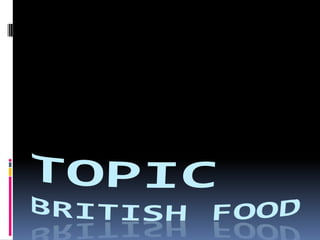
British Food: Sausages, Beans and Tea
- 2. What kind of foods do British people eat? British cuisine means "unfussy dishes made with quality local ingredients, matched with simple sauces to accentuate flavour, rather than disguise it. It uses high-quality local ingredients, preparing them in ways which combine traditional British recipes with modern innovations.
- 5. There are three main meals a day: Breakfast - between 7:00 and 9:00, Lunch - between 12:00 and 1:30 p.m. Dinner (sometimes called Supper) - The main meal, between 6:30 and 8:00 p.m. Afternoon Tea - anywhere between 5:30 at night to 6:30 p.m.
- 6. Breakfast - between 7:00 and 9:00 What is a typical English Breakfast?
- 7. The traditional English breakfast consists of sunny-side-up eggs, fried bread, sausages, mushrooms, bacon, tomatoes and baked beans. It's known in England as the "fry-up" or "Full English Most English people today prefer a breakfast of hot or cold cereal, toast with marmalade or preserves, juice, and a warm beverage of either tea of coffee.
- 10. LUNCH What is a typical British lunch? .Lunch - between 12:00 and 1:30 p.m
- 11. The typical English lunch consists of a sandwich, such as sausage and onion, ham and pickle, or shrimp or tuna and mayonnaise. Along with the sandwich, an English person might have a packet of crisps (potato chips), fruit or biscuits. A pint of beer, tea, coffee or a carbonated beverage.
- 13. Many children at school and adults at work will have a 'packed lunch'. This typically consists of a sandwich, a packet of crisps, a piece of fruit and a drink. The 'packed lunch' is kept in a plastic container.
- 14. Afternoon Tea The afternoon tea is simply a time to snack on a packet of crisps or a few biscuits, and swallow a quick cup of tea or coffee. Tea is also an old-fashioned term for dinner; some English people still use it interchangeably to indicate the last main meal of the day. Tea - anywhere from 5:30 at night to 6:30 p.m.
- 16. DINNER What is a typical British dinner? Dinner (sometimes called Supper) - The main meal. Eaten between 6:30 and 8:00 p.m.
- 17. A typical British meal for dinner is "meat and two veg". We put hot brown gravy, (traditionally made from the juices of the roast meat, but more often today from a packet!) on the meat and usually the vegetables. One of the vegetables is almost always potatoes.
- 19. Sweets, Snacks and Desserts After eating the evening meal, an English person might ask, "What's for afters?" or "What's for pudding?" Puddings have long been a favorite ending to a good, English meal. Spotted Dick (a steamed pudding of suet containing dried currants or sultanas), treacle pudding (a steamed pudding with treacle syrup poured over top), or trifle (sponge cake interspersed with custard, fruit and whipped cream) are all popular, traditional English desserts.
- 22. The Sunday Roast Dinner Sunday lunch time is a typical time to eat the traditional Sunday Roast. Traditionally it consists of roast meat, (cooked in the oven for about two hours), two different kinds of vegetables and potatoes with a Yorkshire puddingThe most common joints are beef, lamb or pork; chicken is also popular.
- 24. What should I do or not do when we are eating in Britain? Things you should do: If you can not eat a certain type of food or have some special needs, tell your host several days before the dinner party. If you are a guest, it is polite to wait until your host starts eating or indicates you should do so. It shows consideration. Always chew and swallow all the food in your mouth before taking more or taking a drink. Always say thank you when served something. It shows appreciation.
- 25. Things you should not do: Never lick or put your knife in your mouth. It is impolite to start eating before everyone has been served unless your host says that you don't need to wait. Never chew with your mouth open. No one wants to see food being chewed or hearing it being chomped on. It is impolite to have your elbows on the table while you are eating. Don't reach over someone's plate for something, ask for the item to be passed. Never talk with food in your mouth. It is impolite to put too much food in your mouth.
- 26. Never use your fingers to push food onto your spoon or fork. It is impolite to slurp your food or eat noisily. Never blow your nose on a napkin (serviette). Napkins are for dabbing your lips and only for that. Never take food from your neighbours plate. Never pick food out of your teeth with your fingernails.
- 27. What do you say or do if you've accidentally taken too much food and you cannot possibly eat it all? "I'm sorry, but it seems that 'my eyes are bigger than my stomach'. "I'm sorry. It was so delicious but I am full". The main thing is not to offend your host
- 28. WORKED BY : AURELA STANA
- 29. THANK YOU !